The Influence of the Evolution of the Innovative Network on Technical Innovation from the Perspective of Energy Transformation: Based on Analysis of the New Energy Vehicle Industry in China
Abstract
1. Introduction
2. Network Evolution Analysis
2.1. Data Source
2.1.1. Data Collection
2.1.2. Data Cleaning
2.2. Network Construction and Evolutionary Analysis
2.2.1. Division of Network Stages
2.2.2. Network Construction
2.2.3. Network Evolution
3. Research Hypothesis
3.1. Network Structure and TI
3.2. Network Content and TI
4. Research Design
4.1. Sample Collection
4.2. Variable Construction
4.2.1. Dependent Variables
4.2.2. Independent Variables
4.2.3. Control Variables
4.3. Inspection Methods
5. Empirical Research
5.1. Descriptive Evidence
5.2. Testing Hypotheses
5.3. Robustness Tests
5.4. Heterogeneity Checks
5.4.1. Heterogeneity in Ownership
5.4.2. Heterogeneity in Type
5.4.3. Heterogeneity in Region
5.5. Discussion
6. Conclusions
6.1. Theoretical Contribution
6.2. Practical Implications
6.3. Limitations and Future Research
Author Contributions
Funding
Institutional Review Board Statement
Informed Consent Statement
Data Availability Statement
Acknowledgments
Conflicts of Interest
References
- Luo, E.X.; Guo, H.W. Research on the interactive effect of dual network and enterprise innovation—Based on the investigation of new energy automobile enterprises in China. J. Ind. Technol. Econ. 2021, 40, 35–41. (In Chinese) [Google Scholar]
- Zapata, C.; Nieuwenhuis, P. Exploring innovation in the automotive industry: New technologies for cleaner cars. J. Clean. Prod. 2010, 18, 14–20. [Google Scholar] [CrossRef]
- Lee, J.; Veloso, F.M.; Hounshell, D.A.; Rubin, E.S. Forcing technological change: A case of automobile emissions control technology development in the US. Technovation 2010, 30, 249–264. [Google Scholar] [CrossRef]
- Sovacool, B.K.; Newell, P.; Carley, S.; Fanzo, J. Equity, technological innovation and sustainable behaviour in a low-carbon future. Nat. Hum. Behav. 2022, 6, 326–337. [Google Scholar] [CrossRef] [PubMed]
- He, Y.; Le, W.; Guo, B.H. Research on the Policy Synergy of Central and Local Government on New Energy Vehicle lndustry under the Perspective of Policy Field and Time Dimension. Chin. J. Manag. Sci. 2021, 29, 12. (In Chinese) [Google Scholar]
- Park, Y.; Nakaoka, I.; Chen., Y. The R&D Strategy of Automobile Companies in Radical Innovation. J. Robot. Netw. Artif. Life 2020, 7, 184–189. [Google Scholar]
- Aytekin, A.; Ecer, F.; Korucuk, S.; Karamaşa, Ç. Global innovation efficiency assessment of EU member and candidate countries via DEA-EATWIOS multi-criteria methodology. Technol. Soc. 2022, 68, 101896. [Google Scholar] [CrossRef]
- Qing, L.; Chun, D.; Ock, Y.S.; Dagestani, A.A.; Ma, X. What myths about green technology innovation and financial performance’s relationship? A bibliometric analysis review. Economies 2022, 10, 92. [Google Scholar] [CrossRef]
- Yang, T.; Xing, C.; Li, X. Evaluation and analysis of new-energy vehicle industry policies in the context of technical innovation in China. J. Clean. Prod. 2021, 281, 125–126. [Google Scholar] [CrossRef]
- Grant, R.M. Toward a knowledge-based theory of the firm. Strateg. Manag. J. 1996, 17, 109–122. [Google Scholar] [CrossRef]
- Chen, W.J.; Zeng, D.M.; Zou, S.M. A study of the evolutionary path of collaborative innovation network for low—carbon vehicle technology. Sci. Res. Manag. 2016, 37, 9. (In Chinese) [Google Scholar]
- Wang, D.D.; Le, W.; Yang, Y.W.; Guo, B.H. Research on the technological innovation network evolution of China’s new energy vehicle industry from the perspective of embeddedness risk. Chin. J. Manag. Sci. 2023, 1–14. [Google Scholar] [CrossRef]
- Sehnem, S.; de Queiroz, A.A.F.S.; Pereira, S.C.F.; dos Santos Correia, G.; Kuzma, E. Circular economy and innovation: A look from the perspective of organizational capabilities. Bus. Strategy Environ. 2022, 31, 236–250. [Google Scholar] [CrossRef]
- Zhang, Q.; Li, C.; Wu, Y. Analysis of Research and Development Trend of the Battery Technology in Electric Vehicle with the Perspective of Patent. Energy Procedia 2017, 105, 4274–4280. [Google Scholar] [CrossRef]
- Plechero, M.; Kulkarni, M.; Chaminade, C.; Parthasarathy, B. Explaining the past, predicting the future: The influence of regional trajectories on innovation networks of new industries in emerging economies. Ind. Innov. 2021, 28, 932–954. [Google Scholar] [CrossRef]
- Peng, M.W.; Luo, Y. Managerial Ties and Firm Performance in a Transition Economy: The Nature of a Micro-Macro Link. Acad. Manag. J. 2000, 43, 486–501. [Google Scholar] [CrossRef]
- Sparrowe, R.T.; Liden, R.C.; Wayne, S.J.; Kraimer, M.L. Social networks and the performance of individuals and groups. Acad. Manag. J. 2001, 44, 316–325. [Google Scholar] [CrossRef]
- Wang, B.; Liu, Y.; Zhou, Y.; Wen, Z. Emerging nanogenerator technology in China: A review and forecast using integrating bibliometrics, patent analysis and technology roadmapping methods. Nano Energy 2018, 46, 322–330. [Google Scholar] [CrossRef]
- Lacasa, I.D.; Shubbak, M.H. Drifting towards innovation: The co-evolution of patent networks, policy, and institutions in China’s solar photovoltaics industry. Energy Res. Soc. Sci. 2018, 38, 87–101. [Google Scholar] [CrossRef]
- Cao, X.; Li, C.Y.; Lin, C.R. An research on the evolution of patent cooperation networks based on new energy vehicles. Sci. Res. Manag. 2019, 40, 179–187. (In Chinese) [Google Scholar]
- Li, Y.; Song, J.; Yang, J. A review on structure model and energy system design of lithium-ion battery in renewable energy vehicle. Renew. Sustain. Energy Rev. 2014, 37, 627–633. [Google Scholar] [CrossRef]
- Jiang, Y.J.; Guo, T.; Wang, S.K.; Yasumoto, M. How to achieve breakthrough innovation in emerging countries—A study based on the comparative analysis of V2X patent data between China and the US. Stud. Sci. Sci. 2021, 39, 1882–1896. (In Chinese) [Google Scholar]
- Sun, H.; Geng, Y.; Hu, L.; Shi, L.; Xu, T. Measuring China’s new energy vehicle patents: A social network analysis approach. Energy 2018, 153, 685–693. [Google Scholar] [CrossRef]
- Xu, X.R.; Tian, S.W.; Wang, J.P. Analysis on the evolution of global new energy vehicle technology innovation cooperation network. J. Ind. Technol. Econ. 2020, 39, 9. (In Chinese) [Google Scholar]
- Xi, L.S.; Zhao, H. The influence mechanism and data test of enterprise esg performance on earnings sustainability. Manag. Rev. 2022, 34, 313–326. (In Chinese) [Google Scholar]
- Liu, W.; Tao, Y.; Bi, K. Capturing information on global knowledge flows from patent transfers: An empirical study using USPTO patents. Res. Policy 2022, 51, 104509. [Google Scholar] [CrossRef]
- Mullor-Sebastian, A. The Product Life Cycle Theory: Empirical Evidence. J. Int. Bus. Stud. 1983, 14, 95–105. [Google Scholar] [CrossRef]
- Zhou, C.; Zeng, G.; Xiaorui, X.; Mi, Z. The Dynamics of China’s electronic information industry innovation networks: An empirical research based on SAO model. Econ. Geogr. 2018, 38, 116–122. (In Chinese) [Google Scholar]
- Quinn, R.W.; Baker, W. Positive Emotions, Instrumental Resources, and Organizational Network Evolution: Theorizing via Simulation Research. Social Networks. Soc. Netw. 2021, 64, 212–224. [Google Scholar] [CrossRef]
- Jacobsen, D.H.; Stea, D.; Soda, G. Intra-Organizational Network Dynamics: Past Progress, Current Challenges, and New Frontiers. Acad. Manag. Ann. 2022, 16, 853–897. [Google Scholar] [CrossRef]
- Li, N.; Lin, R.H.; Xie, Z.Y. Research on the influence mechanism of enterprise exploratory innovation under multiple network embedding. Sci. Res. 2020, 38, 11. (In Chinese) [Google Scholar]
- Powell, W.W.; White, D.R.; Koput, K.W.; Owensmith, J. Network dynamics and field evolution. Am. J. Sociol. 2015, 110, 1132–1205. [Google Scholar] [CrossRef]
- Trippl, M.; Maier, G. Knowledge spillover agents and regional development. Adv. Spat. Sci. 2011, 91–111. Available online: https://link.springer.com/chapter/10.1007/978-3-642-14965-8_5 (accessed on 4 June 2022).
- Chen, Y.; Zhang, H.X.; Wang, Q. An empirical research on the relationship between knowledge resources and enterprise innovation. Sci. Res. Manag. 2018, 39, 8. (In Chinese) [Google Scholar]
- Briscoe, F.; Tsai, W. Overcoming Relational Inertia: How Organizational Members Respond to Acquisition Events in a Law Firm. Adm. Sci. Q. 2011, 56, 408–440. [Google Scholar] [CrossRef]
- Burt, R.S. Structural holes and good ideas. Am. J. Sociol. 2004, 110, 349–399. [Google Scholar] [CrossRef]
- Stea, D.; Pedersen, T.; Soda, G. Keep or drop? The origin and evolution of knowledge relationships in organizations. Br. J. Manag. 2022, 33, 1517–1534. [Google Scholar] [CrossRef]
- Burt, R.S.; Reagans, R.E.; Volvovsky, H.C. Network brokerage and the perception of leadership. Soc. Netw. 2021, 65, 33–50. [Google Scholar] [CrossRef]
- Gargiulo, M.; Benassi, M. Trapped in Your Own Net? Network Cohesion, Structural Holes, and the Adaptation of Social Capital. Organ. Sci. 2000, 11, 183–196. [Google Scholar] [CrossRef]
- Perry-Smith, J.E.; Mannucci, P.V. From Creativity to Innovation: The Social Network Drivers of the Four Phases of the Idea Journey. Acad. Manag. 2017, 42, 53–79. [Google Scholar] [CrossRef]
- Giese, H.; Stok, F.M.; Renner, B. Early social exposure and later affiliation processes within an evolving social network. Soc. Netw. 2020, 62, 80–84. [Google Scholar] [CrossRef]
- Capaldo, A. Network structure and innovation: The leveraging of a dual network as a distinctive relational capability. Strateg. Manag. J. 2007, 28, 585–608. [Google Scholar] [CrossRef]
- Ter Wal, A.L.; Alexy, O.; Block, J.; Sandner, P.G. The best of both worlds: The benefits of open-specialized and closed-diverse syndication networks for new ventures’ success. Adm. Sci. Q. 2016, 61, 393–432. [Google Scholar] [CrossRef] [PubMed]
- Zhao, S.; Jiang, Y.; Peng, X.; Hong, J. Knowledge sharing direction and innovation performance in organizations: Do absorptive capacity and individual creativity matter? Eur. J. Innov. Manag. 2021, 24, 371–394. [Google Scholar] [CrossRef]
- Wang, M.C.; Chen, P.C.; Fang, S.C. A critical view of knowledge networks and innovation performance: The mediation role of firms’ knowledge integration capability. J. Bus. Res. 2018, 88, 222–233. [Google Scholar] [CrossRef]
- Xu, S. Balancing the Two Knowledge Dimensions in Innovation Efforts: An Empirical Examination among Pharmaceutical Firms. J. Prod. Innov. Manag. 2015, 32, 610–621. [Google Scholar] [CrossRef]
- Wu, J.; Shanley, M.T. Knowledge stock, exploration, and innovation: Research on the United States electromedical device industry. J. Bus. Res. 2009, 62, 474–483. [Google Scholar] [CrossRef]
- Luo, Z.Q. Research on the development of organizational technological Innovation ability based on knowledge Attribute. Mod. Manag. Sci. 2019, 1, 53–55. (In Chinese) [Google Scholar]
- Mannucci, P.V.; Yong, K. The Differential Impact of Knowledge Depth and Knowledge Breadth on Creativity over Individual Careers. Acad. Manag. 2018, 61, 1741–1763. [Google Scholar] [CrossRef]
- Thakur-Wernz, P.; Samant, S. Relationship between international experience and innovation performance: The importance of organizational learning for EMNEs. Glob. Strategy J. 2019, 9, 378–404. [Google Scholar] [CrossRef]
- Soda, G.; Usai, A.; Zaheer, A. Network memory: The influence of past and current networks on performance. Acad. Manag. J. 2004, 47, 893–906. [Google Scholar] [CrossRef]
- Garcia-Vega, M. Does technological diversification promote innovation?: An empirical analysis for European firms. Res. Policy 2006, 35, 230–246. [Google Scholar] [CrossRef]
- Yu, J.; Gilbert, B.A.; Oviatt, B.M. Effects of alliances, time, and network cohesion on the initiation of foreign sales by new ventures. Strateg. Manag. J. 2011, 32, 424–446. [Google Scholar] [CrossRef]
- Cameron, A.C.; Trivedi, P.K. Econometric models based on count data: Comparisons and applications of some estimators and tests. J. Appl. Econom. 1985, 1, 29–53. [Google Scholar] [CrossRef]
- Cincera, M. Patents, R&D, and technological spillovers at the firm level: Some evidence from econometric count models for panel date. J. Appl. Econom. 1996, 12, 265–280. [Google Scholar]
- Feng, S.; Zhang, R.; Li, G. Environmental decentralization, digital finance and green technology innovation. Struct. Change Econ. Dyn. 2022, 61, 70–83. [Google Scholar] [CrossRef]
- He, Y.B.; Zhang, Y.C. A study on the impact of network embeddedness on industry- university—Research institute knowledge collaboration performance. Stud. Sci. Sci. 2017, 35, 1396–1408. (In Chinese) [Google Scholar]
- Xie, F.; Chen, X.J.; Dou, T.F. Publication collaboration and research impact: Evidence from universities in China. Stud. Sci. Sci. 2021, 39, 777. (In Chinese) [Google Scholar]
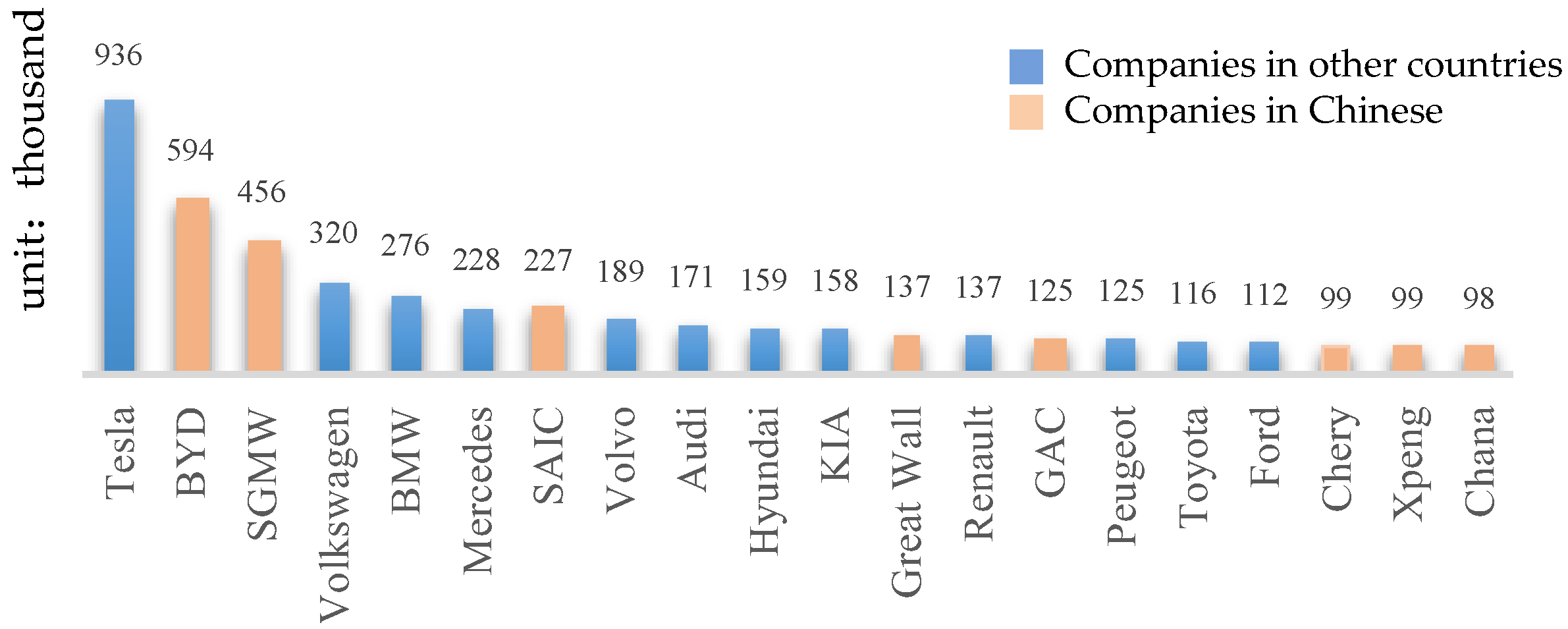

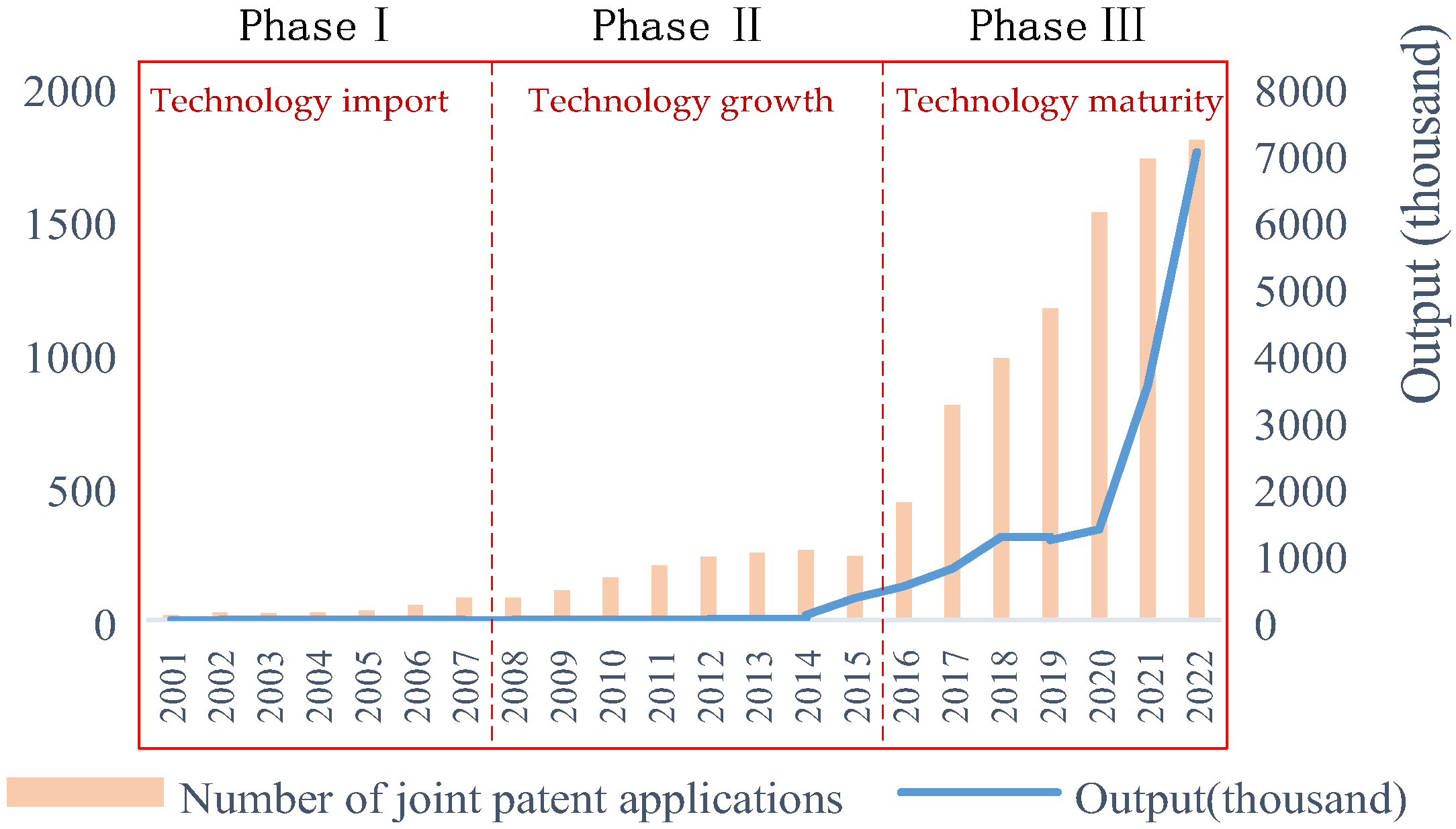

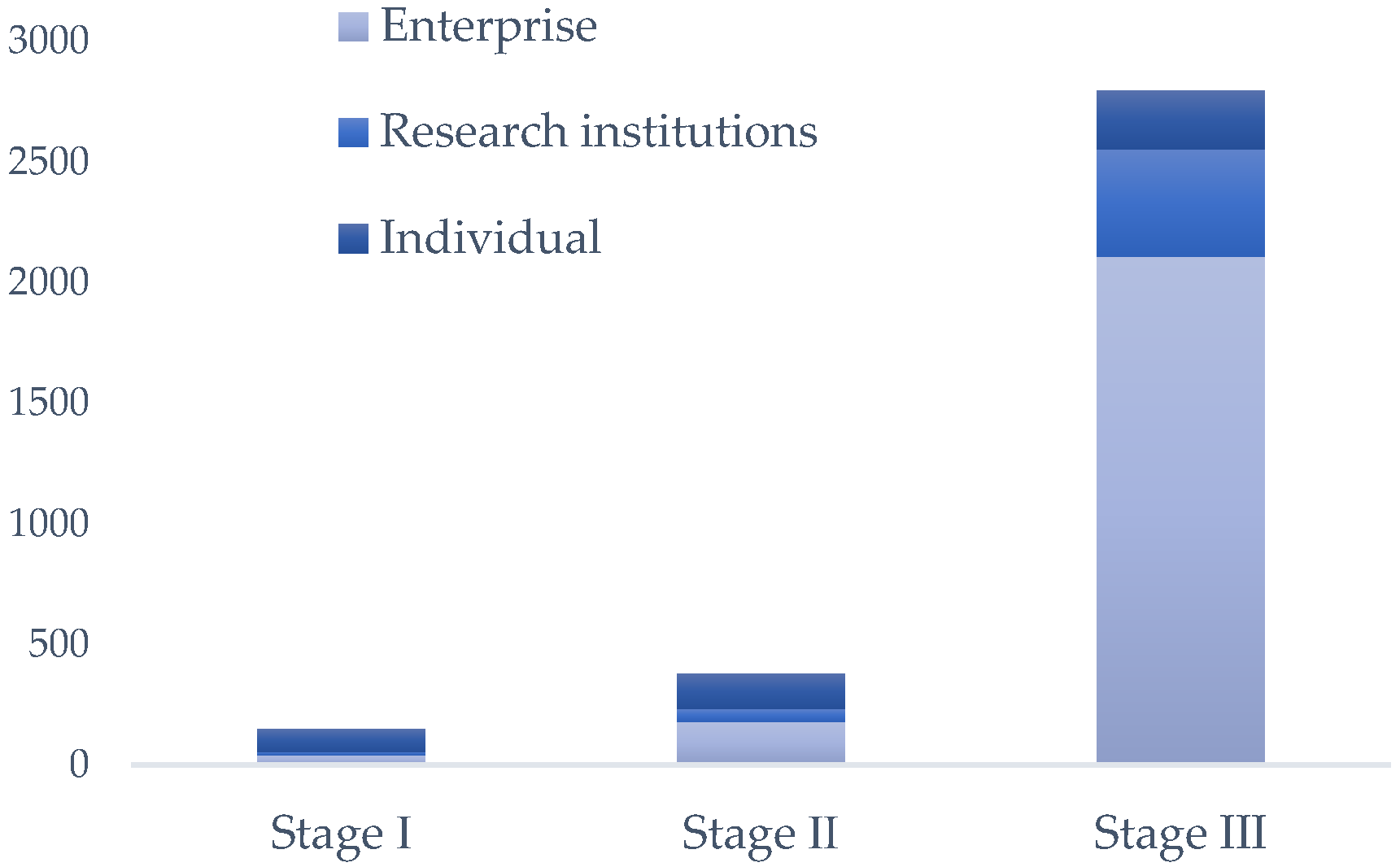

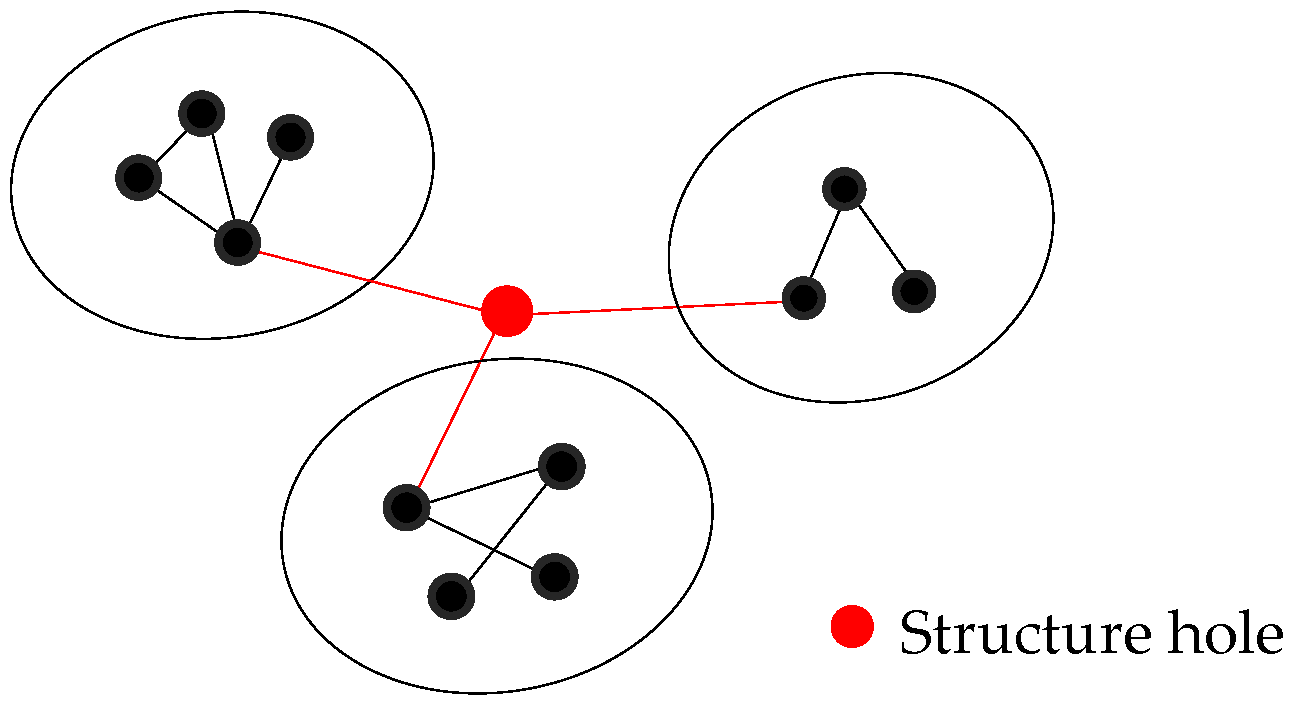
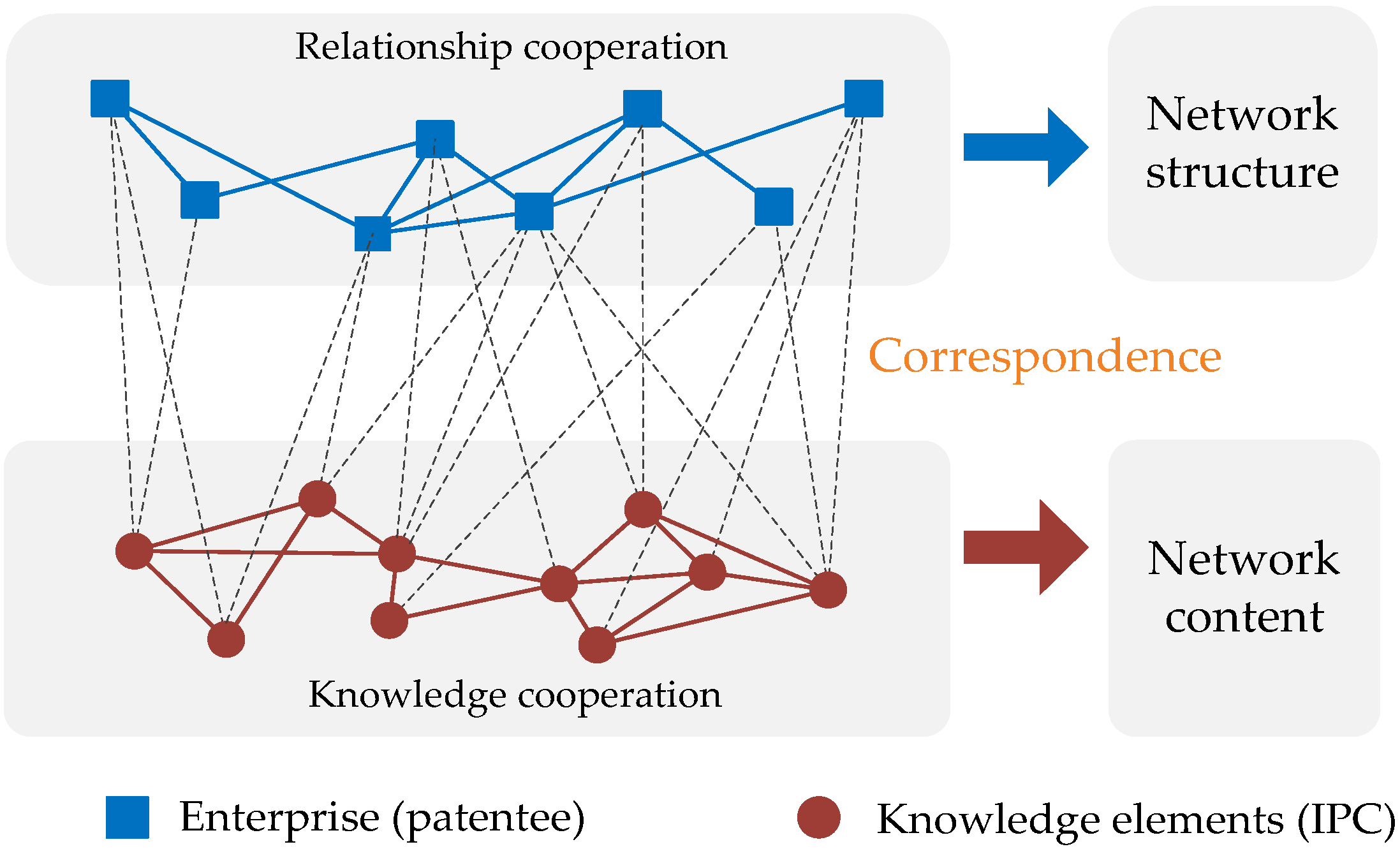


| Phase | Technical Import | Technology Growth | Technical Maturity |
|---|---|---|---|
| Year | 2001–2008 | 2009–2015 | 2016–2022 |
| The evolution of the network |  | ||
| The number of nodes | 46 | 407 | 3108 |
| The number of edges | 25 | 615 | 6008 |
| The number of connections | 94 | 1572 | 9115 |
| Density | 0.025 | 0.002 | 0.001 |
| SD Distance | 0.342 | 0.749 | 0.602 |
| Degree Centralization | 0.044 | 0.154 | 0.018 |
| Variable | Measurement | |
|---|---|---|
| Dependent Variable | Technical innovation (TI) | The number of patents granted in the t-year of NEV enterprise i. |
| Independent Variable | Cooperation breadth (GD) | The number of partners in the enterprise’s egocentric network. |
| Structural hole (SH) | The number of structural holes measured using the constraint. | |
| Technology diversity (KS) | The total number of IPC sub-categories applied for in the t-year of enterprise i. | |
| Technical value (TV) | The logarithm of the total patent value in the t-year of enterprise i. | |
| Control Variable | Age | Measured over the period from the company’s inception to 2022. |
| Size | Measured as the total number of inventors owned in the t-year of enterprise i. | |
| R&D | The proportion of the enterprise’s R & D investment in operating income. | |
| Sales | Measured by the logarithm of operating income. | |
| Property | The enterprise is a listed enterprise, denoted as 1; Non-listed enterprise, denoted as 0. | |
| Year | The dummy variables of 22 years are generated. | |
| Area | The dummy variables of 27 provinces are generated. |
| Variable | Mean | SD | (1) | (2) | (3) | (4) | (5) | (6) | (7) | (8) | (9) | (10) | VIF | |
|---|---|---|---|---|---|---|---|---|---|---|---|---|---|---|
| (1) | TI | 221.381 | 643.940 | 1 | - | |||||||||
| (2) | GD | 4.270 | 6.643 | 0.196 | 1 | 1.21 | ||||||||
| (3) | SH | 1.673 | 0.142 | 0.443 | 0.215 | 1 | 3.39 | |||||||
| (4) | KS | 22.317 | 25.093 | 0.774 | 0.150 | 0.576 | 1 | 3.41 | ||||||
| (5) | TV | 13.704 | 2.322 | 0.534 | 0.136 | 0.556 | 0.635 | 1 | 1.93 | |||||
| (6) | Age | 11.678 | 10.040 | 0.173 | 0.006 | 0.221 | 0.296 | 0.299 | 1 | 1.29 | ||||
| (7) | Size | 170.641 | 376.090 | 0.862 | 0.329 | 0.496 | 0.784 | 0.563 | 0.269 | 1 | 3.70 | |||
| (8) | R&D | 0.717 | 2.223 | 0.287 | 0.061 | 0.186 | 0.263 | 0.207 | 0.231 | 0.300 | 1 | 1.15 | ||
| (9) | Sales | 23.852 | 0.553 | 0.691 | 0.202 | 0.812 | 0.705 | 0.582 | 0.211 | 0.702 | 0.291 | 1 | 4.81 | |
| (10) | Property | 0.138 | 0.345 | 0.150 | -0.006 | 0.122 | 0.192 | 0.093 | 0.345 | 0.236 | 0.132 | 0.158 | 1 | 1.19 |
| TI | |||||||
|---|---|---|---|---|---|---|---|
| Mode 1 | Mode 2 | Mode 3 | Mode 4 | Mode 5 | Mode 6 | ||
| Control Variable | Age | 0.014 *** | 0.014 *** | 0.011 ** | 0.008 ** | 0.002 | −0.001 |
| (0.005) | (0.005) | (0.005) | (0.004) | (0.004) | (0.003) | ||
| Size | 0.002 *** | 0.002 *** | 0.002 *** | −0.000 *** | 0.001 *** | −0.000 | |
| (0.000) | (0.000) | (0.000) | (0.000) | (0.000) | (0.000) | ||
| R&D | −0.016 | −0.015 | −0.010 | −0.013 | −0.011 | −0.001 | |
| (0.016) | (0.016) | (0.017) | (0.015) | (0.014) | (0.019) | ||
| Sales | 1.139 *** | 1.119 *** | 0.252 * | 0.874 *** | 0.823 *** | 0.075 | |
| (0.103) | (0.099) | (0.143) | (0.088) | (0.088) | (0.096) | ||
| Property | −0.389 *** | −0.440 *** | −0.258 * | −0.374 *** | −0.226 ** | −0.241 *** | |
| (0.142) | (0.137) | (0.137) | (0.102) | (0.115) | (0.079) | ||
| Year | YES | YES | YES | YES | YES | YES | |
| Area | YES | YES | YES | YES | YES | YES | |
| Independent Variable | GD | 0.064 *** | 0.017 ** | ||||
| (0.012) | (0.007) | ||||||
| GD2 | −0.002 *** | −0.000 | |||||
| (0.001) | (0.000) | ||||||
| SH | 3.852 *** | 2.485 *** | |||||
| (0.482) | (0.325) | ||||||
| KS | 0.044 *** | 0.033 *** | |||||
| (0.003) | (0.002) | ||||||
| TV | 0.304 *** | 0.202 *** | |||||
| (0.021) | (0.016) | ||||||
| Constant | −23.226 *** | −22.950 *** | −8.593 *** | −17.551 *** | −19.636 *** | −5.233 *** | |
| (2.443) | (2.352) | (2.798) | (2.079) | (2.056) | (1.896) | ||
| N | 1706 | 1706 | 1706 | 1706 | 1706 | 1706 | |
| R2 | 0.1188 | 0.1240 | 0.1304 | 0.1698 | 0.1548 | 0.2164 | |
| The Number of Cited Patents | The Number of Patent Applications is Delayed in Two Cycles | |||||||||
|---|---|---|---|---|---|---|---|---|---|---|
| Mode 1 | Mode 2 | Mode 3 | Mode 4 | Mode 5 | Mode 6 | Mode 7 | Mode 8 | Mode 9 | Mode 10 | |
| GD | 0.061 *** | 0.016 | 0.013 *** | 0.010 | ||||||
| (0.018) | (0.014) | (0.004) | (0.075) | |||||||
| GD2 | −0.002 *** | −0.000 | −0.001 ** | −0.001 * | ||||||
| (0.000) | (0.000) | (0.000) | (0.001) | |||||||
| SH | 3.077 *** | 0.986 * | 4.370 *** | 4.345 *** | ||||||
| (0.696) | (0.593) | (0.143) | (0.147) | |||||||
| KS | 0.034 *** | 0.016 *** | 0.003 *** | −0.001 | ||||||
| (0.005) | (0.004) | (0.001) | (0.002) | |||||||
| TV | 0.397 *** | 0.356 *** | 0.047 *** | 0.008 | ||||||
| (0.023) | (0.024) | (0.009) | (0.005) | |||||||
| Controls | YES | YES | YES | YES | YES | YES | YES | YES | YES | YES |
| Year | YES | YES | YES | YES | YES | YES | YES | YES | YES | YES |
| Area | YES | YES | YES | YES | YES | YES | YES | YES | YES | YES |
| Constant | −15.812 *** | −4.780 | −15.721 *** | −13.203 *** | −7.822 ** | −47.178 *** | −33.076 *** | −46.493 *** | −46.299 *** | −32.845 *** |
| (3.529) | (4.287) | (3.579) | (2.864) | (3.517) | (1.013) | (0.544) | (1.045) | (0.980) | (0.549) | |
| N | 1706 | 1706 | 1706 | 1706 | 1706 | 1706 | 1706 | 1706 | 1706 | 1706 |
| R2 | 0.0848 | 0.0861 | 0.0929 | 0.1206 | 0.1264 | 0.2837 | 0.4285 | 0.2838 | 0.2884 | 0.4309 |
| State-Owned Enterprises | Non-State-Owned Enterprises | |||||||||
|---|---|---|---|---|---|---|---|---|---|---|
| Mode 1 | Mode 2 | Mode 3 | Mode 4 | Mode 5 | Mode 1 | Mode 2 | Mode 3 | Mode 4 | Mode 5 | |
| GD | 0.065 | 0.012 | 0.083 *** | 0.020 ** | ||||||
| (0.044) | (0.028) | (0.014) | (0.008) | |||||||
| GD2 | −0.002 | −0.000 | −0.002 *** | −0.000 | ||||||
| (0.001) | (0.000) | (0.000) | (0.000) | |||||||
| SH | 3.067 ** | 0.788 | 4.263 *** | 2.696 *** | ||||||
| (1.449) | (0.916) | (0.513) | (0.343) | |||||||
| KS | 0.044 *** | 0.036 *** | 0.046 *** | 0.033 *** | ||||||
| (0.006) | (0.004) | (0.003) | (0.002) | |||||||
| TV | 0.373 *** | 0.261 *** | 0.397 *** | 0.187 *** | ||||||
| (0.059) | (0.045) | (0.030) | (0.017) | |||||||
| Controls | YES | YES | YES | YES | YES | YES | YES | YES | YES | YES |
| Constant | −29.402 *** | −16.966 ** | −10.052 ** | −25.201 *** | −5.850 | −22.416 *** | −7.152 ** | −20.504 *** | −18.550 *** | −6.485 *** |
| (5.022) | (6.711) | (3.976) | (3.821) | (4.490) | (2.974) | (3.313) | (2.496) | (2.619) | (2.234) | |
| N | 373 | 373 | 373 | 373 | 373 | 1333 | 1333 | 1333 | 1333 | 1333 |
| R2 | 0.1253 | 0.1270 | 0.1733 | 0.1542 | 0.2079 | 0.1278 | 0.1352 | 0.1723 | 0.1562 | 0.2229 |
| Traditional Automobile Enterprises | Emerging Automobile Companies | |||||||||
|---|---|---|---|---|---|---|---|---|---|---|
| Mode 1 | Mode 2 | Mode 3 | Mode 4 | Mode 5 | Mode 1 | Mode 2 | Mode 3 | Mode 4 | Mode 5 | |
| GD | 0.051 *** | 0.015 | 0.079 *** | 0.035 ** | ||||||
| (0.017) | (0.010) | (0.026) | (0.018) | |||||||
| GD2 | −0.001 *** | −0.000 | −0.003 *** | −0.001 * | ||||||
| (0.000) | (0.000) | (0.001) | (0.001) | |||||||
| SH | 2.941 *** | 1.770 *** | 4.017 *** | 2.768 *** | ||||||
| (0.720) | (0.444) | (0.682) | (0.511) | |||||||
| KS | 0.039 *** | 0.030 *** | 0.049 *** | 0.035 *** | ||||||
| (0.003) | (0.002) | (0.006) | (0.005) | |||||||
| TV | 0.371 *** | 0.252 *** | 0.255 *** | 0.175 *** | ||||||
| (0.030) | (0.023) | (0.032) | (0.026) | |||||||
| Controls | YES | YES | YES | YES | YES | YES | YES | YES | YES | YES |
| Year | YES | YES | YES | YES | YES | YES | YES | YES | YES | YES |
| Area | YES | YES | YES | YES | YES | YES | YES | YES | YES | YES |
| Constant | −19.799 *** | −11.093 *** | −16.914 *** | −17.545 *** | −6.666 *** | −27.343 *** | −2.146 | −19.311 *** | −23.563 *** | −3.197 |
| (2.762) | (3.524) | (2.418) | (2.296) | (2.152) | (5.440) | (6.503) | (4.507) | (4.598) | (4.503) | |
| N | 919 | 919 | 919 | 919 | 919 | 787 | 787 | 787 | 787 | 787 |
| R2 | 0.1151 | 0.1161 | 0.1626 | 0.1541 | 0.2143 | 0.1132 | 0.1241 | 0.1439 | 0.1382 | 0.1867 |
| Eastern Regions | Middle Regions | Western Regions | ||||||||||
|---|---|---|---|---|---|---|---|---|---|---|---|---|
| Mode 1 | Mode 2 | Mode 3 | Mode 4 | Mode 1 | Mode 2 | Mode 3 | Mode 4 | Mode 1 | Mode 2 | Mode 3 | Mode 4 | |
| GD | 0.062 *** | 0.119 | 0.070 | |||||||||
| (0.013) | (0.097) | (0.066) | ||||||||||
| GD2 | −0.002 *** | −0.006 | −0.002 | |||||||||
| (0.000) | (0.007) | (0.002) | ||||||||||
| SH | 4.650 *** | 3.956 *** | 5.395 ** | |||||||||
| (0.522) | (1.008) | (2.251) | ||||||||||
| KS | 0.044 *** | 0.044 *** | 0.070 *** | |||||||||
| (0.003) | (0.009) | (0.014) | ||||||||||
| TV | 0.296 *** | 0.211 *** | 0.318 *** | |||||||||
| (0.023) | (0.055) | (0.072) | ||||||||||
| Controls | YES | YES | YES | YES | YES | YES | YES | YES | YES | YES | YES | YES |
| Year | YES | YES | YES | YES | YES | YES | YES | YES | YES | YES | YES | YES |
| Area | YES | YES | YES | YES | YES | YES | YES | YES | YES | YES | YES | YES |
| Constant | −25.830 *** | −11.822 *** | −17.299 *** | −21.124 *** | −15.790 *** | 3.599 | −16.895 *** | −16.285 *** | −55.041 *** | −27.995 ** | −4.747 | −33.427 *** |
| (2.905) | (3.120) | (2.354) | (2.459) | (5.211) | (6.628) | (4.581) | (4.774) | (10.163) | (13.524) | (11.169) | (8.292) | |
| N | 1329 | 1329 | 1329 | 1329 | 235 | 235 | 235 | 235 | 142 | 142 | 142 | 142 |
| R2 | 0.1248 | 0.1364 | 0.1646 | 0.1548 | 0.1832 | 0.1984 | 0.2107 | 0.1968 | 0.1542 | 0.1656 | 0.2003 | 0.1908 |
Disclaimer/Publisher’s Note: The statements, opinions and data contained in all publications are solely those of the individual author(s) and contributor(s) and not of MDPI and/or the editor(s). MDPI and/or the editor(s) disclaim responsibility for any injury to people or property resulting from any ideas, methods, instructions or products referred to in the content. |
© 2023 by the authors. Licensee MDPI, Basel, Switzerland. This article is an open access article distributed under the terms and conditions of the Creative Commons Attribution (CC BY) license (https://creativecommons.org/licenses/by/4.0/).
Share and Cite
Wang, Z.; Wang, C.; Feng, T.; Wang, Y. The Influence of the Evolution of the Innovative Network on Technical Innovation from the Perspective of Energy Transformation: Based on Analysis of the New Energy Vehicle Industry in China. Sustainability 2023, 15, 4237. https://doi.org/10.3390/su15054237
Wang Z, Wang C, Feng T, Wang Y. The Influence of the Evolution of the Innovative Network on Technical Innovation from the Perspective of Energy Transformation: Based on Analysis of the New Energy Vehicle Industry in China. Sustainability. 2023; 15(5):4237. https://doi.org/10.3390/su15054237
Chicago/Turabian StyleWang, Zeqian, Chengjun Wang, Tao Feng, and Yalan Wang. 2023. "The Influence of the Evolution of the Innovative Network on Technical Innovation from the Perspective of Energy Transformation: Based on Analysis of the New Energy Vehicle Industry in China" Sustainability 15, no. 5: 4237. https://doi.org/10.3390/su15054237
APA StyleWang, Z., Wang, C., Feng, T., & Wang, Y. (2023). The Influence of the Evolution of the Innovative Network on Technical Innovation from the Perspective of Energy Transformation: Based on Analysis of the New Energy Vehicle Industry in China. Sustainability, 15(5), 4237. https://doi.org/10.3390/su15054237







